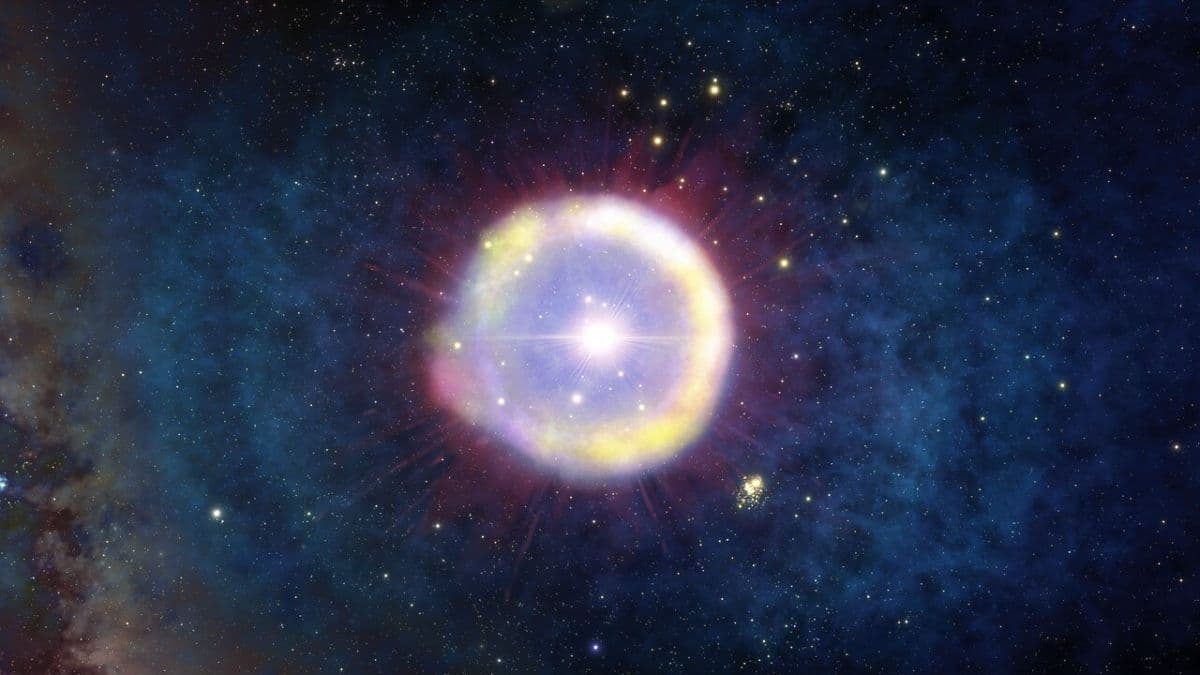Astronomers may have found the chemical traces of the one of earliest stars — born when the universe was just 100 million years old — that exploded in a “super-supernova.”
These first-generation stars, known as Population III stars, ended their lives in titanic supernova explosions that seeded the universe with chemical elements the stars had forged during their lifetimes. This material was then incorporated in the next generation of stars, planets and even us, which means that understanding how these earliest stars enriched the universe with heavy elements is vital to understanding its evolution over its 13.7-billion-year history.
But astronomers have been unable to find direct evidence of one of these earliest, Population III stars — until now.
A team of scientists used the 8.1-meter Gemini North telescope on the island of Hawai’i to analyze an extremely distant quasar, a superbright object powered by a massive black hole, as it was 13.1 billion years ago, when the universe was just 700 million years old, and found a cloud with a distinctive chemical signature surrounding the object.
The researchers were able to deduce the chemical elements in the cloud and found an unusually high ratio of iron to magnesium — 10 times greater than the same ratio in the sun. The astronomers think this could debris cloud only be the result of a first-generation star with a mass 300 times greater than the sun that exploded in a remarkably powerful supernova called a pair-instability supernova.
Astronomers have yet to witness a pair-instability supernova, but theorize that these dramatic explosions occur when gigantic stars with masses between 150 and 250 times that of the sun reach the end of their lives.
During this massive cosmic explosion, the thinking goes, photons in the center of a star spontaneously turn into negatively charged electrons and their positively charged counterparts, positrons. This ends the outward radiation pressure that supports stars against the inward force of gravity during their lives. As a result, the star experiences gravitational collapse, triggering a supernova explosion that blasts away the outer layers.
But where ordinary supernovas leave behind stellar remnants in the form of neutron stars or black holes, pair-instability supernovas do not, instead, blasting all their material into space.
That means that these supernovas can’t be spotted by looking for stellar remnants, so can only be tracked in two ways: either by directly witnessing them as they happen — highly unlikely given how vast space is — or by spotting the chemical signature of the material they blast out.
“It was obvious to me that the supernova candidate for this would be a pair-instability supernova of a Population III star, in which the entire star explodes without leaving any remnant behind,” research co-author and University of Tokyo astronomer Yuzuru Yoshii, said in a statement. “I was delighted and somewhat surprised to find that a pair-instability supernova of a star with a mass about 300 times that of the sun provides a ratio of magnesium to iron that agrees with the low value we derived for the quasar.”
Spotting the chemical signature of a first-generation star
Along with research co-authors fellow University of Tokyo astronomer Hiroaki Sameshima and University of Notre Dame astronomer Timothy Beers, Yoshii turned to prior observations made by the 8.1-meter Gemini North telescope using the Gemini Near-Infrared Spectrograph (GNIRS) to hunt for signatures of exploded Population III stars.
Because elements absorb and emit light at specific wavelengths, they leave distinctive ‘fingerprints’ on the light that passes through a cloud or an atmosphere. Spectrographs like GNIRS take this light and identify elements by this fingerprint, thus determining the chemical composition of the cloud. Determining the quantities of an element, however, remains difficult since the brightness of a signature can depend on factors other than abundance.
The University of Tokyo astronomers tackled this problem by developing a method that relies on the intensity of wavelengths of light coming from a quasar’s light spectrum. This approach allowed the scientists to determine the abundance of elements in clouds surrounding that quasar, revealing the unusually high amount of iron compared to magnesium.
Yoshii and the team think this is the clearest indicator yet of a Population III star and a pair-instability supernova. The team wants to investigate similar quasar clouds and attempt to discover if they also possess these characteristics.
And although high-mass Population III stars would have ended their lives long ago and thus the event would only be visible far away, their chemical signatures may be detectable closer to home. The team thinks that the pair-instability signature may last a long time, so the evidence of long-dead stars may also be found imprinted on objects in the local universe.
“We now know what to look for; we have a pathway,” Beers said in the same statement. “If this happened locally in the very early universe, which it should have done, then we would expect to find evidence for it.”
The team’s research is available as a preprint on the research repository arXiv.org and will be published in the Astrophysical Journal.

